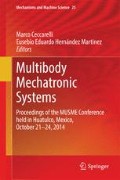Abstract
Exploration in high-risk areas is a topic that has motivated the development of mobile robotics in recent years. Moreover, the incursion of multi-agent systems in this field has opened a lot of solutions and applications. In this paper we propose a strategy of exploration and mapping for multi-robot systems in underground mines where toxic gases concentration (\( {\text{ex}}.: {\text{CO}}_{2} \), \( {\text{CO}} \), \( {\text{Sb}} \)) is unknown. The principal algorithm is the behavior control which evaluates the status of each agent and makes decisions that maximize system performance and minimize the cost of them. We will use scanning algorithms based on dynamic graph to reduce bandwidth consumption and use of memory. The system has been tested by simulating several situations such as partial loss of communications or agents.
Access this chapter
Tax calculation will be finalised at checkout
Purchases are for personal use only
References
Panait L, Luke S (2005) Cooperative multi-agent learning: the state of the art. Auton Agent Multi-Agent Syst 11(3):387–434
Parker LE (2000) Current state of the art in distributed autonomous mobile robotics. Distributed autonomous robotic systems, vol 4. Springer, Japan, pp 3–12
Das A, Frank LL (2011) Distributed adaptive control for networked multi-robot systems. Multi-robot systems, trends and development, pp 33–52
Şahin E (2005) Swarm robotics: from sources of inspiration to domains of application. Swarm robotics. Springer, Heidelberg, pp 10–20
Thrun S et al (2004) Autonomous exploration and mapping of abandoned mines. Robotics and Automation Magazine, IEEE 11.4, pp 79–91
Yinka-Banjo, Chika AB, and Isaac O (2013) Osunmakinde. Autonomous multi-robot behaviours for safety inspections under the constraints of underground mine terrains
Cepeda JS et al. (2012) A behavior-based strategy for single and multi-robot autonomous exploration. Sensors12.9:12772–12797
Reid S, Enk K, John B (1991) A six-legged rover for planetary exploration. In: Proceedings of Computrny in Aerocpuc e 8, 4IAA. pp 739–747, Oct 1991
Erann G, Rajiv D, Robert I, John L, David PM (2002) Behavior control for robotic exploration of planetary surfaces. In: Robotics and automation. IEEE Transactions, vol 10, #4, pp 490–503 Aug 2002
Zhiqi L, Naoyuki K (2007) Hybrid learning approach based on multi-objective behavior coordination for multiple robots. In: Proceedings of the 2007 IEEE International Conference on Mechatronics and Automation
Umit YO, Oguz HD, Umit O (2004) Cooperative control of mobile robots for target search. Proceedings of the IEEE International Conference on Mechatronics
Sebastian T, Wolfram B (2005) Probabilistic robotics. The MIT Press
Montemerlo, Michael, “FastSLAM (2003) A factored solution to the simultaneous localization and mapping problem with unknown data association. Doctoral dissertation, tech. report CMU-RI-TR-03-28, Robotics Institute, Carnegie Mellon University
Mejdi Ben Ardhaoui (2011) Implementation of autonomous navigation and mapping using a laser line scanner on a tactical unmanned aerial vehicle. Naval Postgraduate School, California
López Garcia Diego A (2011) New contributions in scheduling algorithms for executing maneuvers in autonomous robots non-holonomic. Electronic Engineering Department, Huelva University, July 2011
Guivant JE, Brett S, Mark AW (2012) 2D path planning based on Dijkstra’s algorithm and pseudo priority queues, SOCS
Acknowledgments
This research has been supported by the CTIC-UNI (Center for Information and Communication Technologies—Universidad Nacional de Ingeniería) and by the grant 136-FINCYT-IA-2013 from the Fondo para la Innovación, Ciencia y Tecnología—FINCyT Peru (Fund for Innovation, Science and Technology).
Author information
Authors and Affiliations
Corresponding author
Editor information
Editors and Affiliations
Rights and permissions
Copyright information
© 2015 Springer International Publishing Switzerland
About this paper
Cite this paper
Mauricio, A. et al. (2015). Multi-robot Exploration and Mapping Strategy in Underground Mines by Behavior Control. In: Ceccarelli, M., Hernández Martinez, E. (eds) Multibody Mechatronic Systems. Mechanisms and Machine Science, vol 25. Springer, Cham. https://doi.org/10.1007/978-3-319-09858-6_10
Download citation
DOI: https://doi.org/10.1007/978-3-319-09858-6_10
Published:
Publisher Name: Springer, Cham
Print ISBN: 978-3-319-09857-9
Online ISBN: 978-3-319-09858-6
eBook Packages: EngineeringEngineering (R0)

